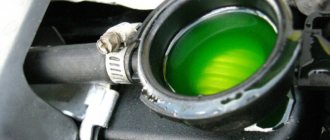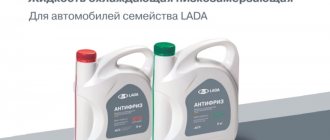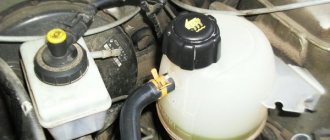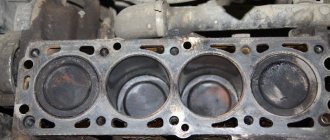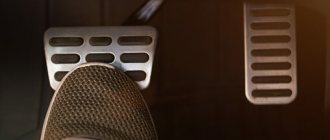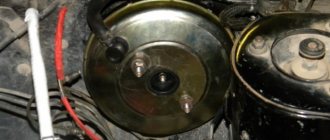Main causes of leaks
Cooling of the VAZ-2114 is carried out as follows:
- coolant from the tank enters the water circuit (“jacket”) of the engine;
- antifreeze circulates in the “jacket” in a small circle until it reaches +95° C along with the engine;
- the thermostatic valve opens and antifreeze is delivered to the radiator for cooling;
- excess liquid that is formed as a result of expansion during heating is returned to the expansion tank.
Thus, sources of antifreeze or antifreeze leakage can be:
- The expansion tank itself - under the influence of alcohol antifreeze, cracks may appear on it.
Cracks in the cylinder head
Very often, cracks form in the cylinder head due to overheating. Cracks are very difficult to detect. As a rule, they are hidden. Cracks can form between the cavity of the cooling system and the inlet channels and exhaust channels. Cracks also often form between the cylinder head valves.
If antifreeze enters the intake passage, it is drawn into the combustion chamber. The exhaust channel releases the antifreeze into the exhaust pipe. A crack between the valves allows antifreeze into the combustion chamber.
Externally, the presence of cracks can be determined by the appearance of white plaque in the channels. When antifreeze evaporates, it leaves traces of a white coating on the internal cavities of the channels. But it is possible to finally confirm that there are cracks in the cylinder head only after crimping the cylinder head using special equipment.
Moreover, the cylinder head must be heated during pressure testing. Because cracks begin to open only when heated.
How to detect a leak
The easiest way to detect the cause of the leak is if antifreeze leaves the expansion tank of the VAZ 2114. In this situation, the liquid may end up under the driver's mat or the hood of the car.
Also, to understand exactly where the leak is located, you can put a sheet of cardboard or paper under the hood and start the engine for about half an hour. Drops on the sheet will indicate the location of the leak.
To find out exactly where the VAZ 2114 antifreeze goes, you need to conduct a thorough inspection of the cooling system:
- Hoses and pipes - usually cracks on them are visible immediately upon inspection. If coolant leaks at the joints, oily traces indicate a leak.
- Radiator – this is where the leak is harder to notice due to scale or dirt. Therefore, it is recommended to carry out a pressure test. The upper pipe from the radiator is disconnected, plugged, and pressure is built up with a compressor. If a leak appears, the radiator must be removed and welded.
- Thermostat (in the injection model, located under the air filter) - in this case, the valve “jamming” is observed, since it is subject to mechanical stress and high temperatures.
- Engine jacket - in this case, the engine begins to “trouble”, and a large amount of steam comes out of the exhaust pipe. At the same time, engine oil becomes gray in color and changes consistency.
- Expansion tank cap - to check this cause of the leak, you need to start the engine by removing the cap from the tank and holding down the accelerator. If the fluid level rises sharply, then there is a leak here.
- The cylinder head gasket is worn or loose. In places of leakage, coolant usually “bulges out”. Also in this case, antifreeze or antifreeze may get into the engine oil.
Important! If a characteristic odor enters the cabin or white steam is formed coming from the exhaust pipe, it means that coolant has entered the engine oil. If antifreeze circulates in the system, the engine cylinder head may fail due to this. If VAZ 2114 antifreeze is leaking, then getting into the oil does not lead to such critical consequences, but still the leak must be eliminated as quickly as possible.
Remedies
Before starting repairs, you should figure out where and why the antifreeze is leaking, that is, make a diagnosis. Leaking hoses are easy to identify, as are fluid emissions from the tank - colored streaks are visible in the area of the lid. It’s more complicated with radiators - the holes in the pipes are usually small, they are blown by an air flow as they go, and leaks are invisible at first glance.
Advice. Fill the car's cooling system with antifreeze containing a fluorescent additive. It reflects the light of an ultraviolet lamp, making the slightest drips clearly visible.
Various problems can be resolved in the following ways:
- Try to clean and rinse the faulty valve of the expansion tank plug. If this does not help, the part should be replaced; it is inexpensive.
- A burst tank should be replaced. There is a practice of repairing plastic containers by soldering, but this option is not very reliable - the body may crack with the next pressure surge.
- Leaking hoses are definitely replaced. The exception is a crack at the very end, then the pipe is trimmed (if the length allows).
- A leaky pump seal must be replaced only on old Zhiguli VAZ 2101–07. On other cars it is replaced together with the water pump.
- Car radiators can be repaired if the cracks in the honeycombs are not the result of corrosion of the aluminum alloy. In any case, the unit must be removed and taken to a service center for inspection.
- A broken cylinder head gasket must be replaced immediately; you cannot drive with this damage. The work involves disassembling the engine; it should be entrusted to a master mechanic.
If one of the listed troubles happens to you on the road, you can add water to the cooling system to get to the garage or car service center. The exception is a gasket burnout, after which you cannot move on. Turn off the engine and tow the car.
Repair of the cooling system on a VAZ 2114
To fix a leak with your own hands, depending on the breakdown, you must:
- replace the damaged hose or pipe, or, if the problem is in the fastening, install another clamp slightly higher than the old one;
Important! All repair work should only be carried out with the engine turned off and the cooling fluid cooled down.
Some work is recommended to be carried out exclusively at a service station.
- Checking and repairing leaks in the radiator.
- Replacing the gasket between the cylinders and engine valves.
- Repairing or replacing the engine water jacket.
Hidden problems
You have looked at everything and everyone, there are no leaks anywhere, all the hoses and clamps are in order, but the antifreeze or antifreeze goes away, “even if you crack”! The fact is that there are not only open leaks, but also so-called hidden ones, and they are much more dangerous.
A car engine is not a cast structure - there is a separate engine block and cylinder head. There is a gasket between these two parts, this is mandatory, it is high-temperature (can maintain high positive values), and it is also a sealing link. In the engine block, as well as in the cylinder head, there are channels through which antifreeze (antifreeze) passes, cooling the metal, thus the “entire engine” is at an operating temperature that does not exceed 90 - 100 degrees Celsius, without this fluid the engine would very quickly warmed up and it simply jammed.
Coolant replacement
First of all, you need to drain the old antifreeze through the drain hole in the radiator. In this case, it is necessary to protect the generator from liquid ingress. You can speed up the draining process by removing the lid from the tank.
Attention! If the drained antifreeze is green, then it cannot be used because it has lost its cooling properties.
- Remove the heating pipe for the throttle body.
- Fill the liquid slightly above the level indicated on the reservoir.
- Press the nozzle to pump out the air.
Thus, detecting a leak in a VAZ-2114 is quite simple. You just need to carefully inspect the cooling system. And fixing a leak will not be a problem for an experienced car owner.
Simplified operation of the VAZ 2114 cooling system
The coolant enters the water jacket of the engine block through the pipes. In the water jacket, the coolant circulates in a small circle until the engine (and therefore the coolant) reaches a temperature of 95 degrees Celsius.
At this moment, the thermostat opens and coolant is delivered through the pipes to the radiator. The radiator removes excess heat from the coolant. Excess hot coolant returns to the expansion tank.
The entire cooling system is under high pressure of 1.2-1.8 atmospheres, due to the operation of the pump and the increase in coolant volume due to heating.
From the above text we conclude: malfunctions of the cooling system are not easy to detect with small leaks, since the coolant evaporates almost immediately, having a high temperature, and work to find the location of the leak sometimes requires the intervention of a professional.
Step 1. The pipe burst
Since the pipes are the “blood vessels” of the car, failure of any of them will result in loss of coolant.
This malfunction is clearly visible on a warm engine while driving. A large amount of steam appears from under the hood. The burst pipe is clearly visible.
But there are times when the coolant leak is small. Then, first of all, attention should be paid to the articulation of the pipes with the vehicle components.
When using coolant in the form of antifreeze or antifreeze, a characteristic oily coating remains in the leak areas.
Step 2. Radiator problem
A radiator malfunction is extremely difficult to detect. At the site of a coolant leak, a large amount of scale sometimes forms, making it difficult to see the location of the damage.
Pay attention to the tightness of the filler plug. If everything is OK with the tightness, then to check you will need a compressor with a pressure gauge or a pump.
Disconnect the upper pipe and connect the compressor. The pipe must be plugged. We create excess pressure and see where the leak appears. We dismantle the radiator. We take it to a specialized service center, where they will check it again under pressure, find a leak (there may be more than one) and weld it with a special compound.
Step 3. Gases in the expansion tank
This malfunction occurs due to the entry of exhaust gases (a specific smell is clearly felt in the car interior) into the cooling system under enormous pressure of 90-96 kPa.
The reason is a faulty gasket between the valve head and the cylinder block. It is caused by coolant leaking from under the expansion tank cap.
The check is quite simple. We start the engine on a cold car, remove the cap from the expansion tank and sharply press the accelerator (in common parlance, the gas pedal).
If the coolant rises sharply, the gasket must be replaced. Stop operating the vehicle immediately until the problem is resolved.
Sometimes the expansion tank cap, due to spring wear, may not withstand coolant pressure.
Step 4. Gray emulsion instead of oil
If you notice that your car has started to “trouble”, a large amount of steam comes out of the exhaust pipe, which smells like coolant. The amount of coolant is constantly decreasing and when checking the oil dipstick, it is clear that the oil has turned into a gray emulsion.
All this indicates a malfunction of the cooling jacket of the engine cylinder block. I categorically do not recommend operating the car in this condition! In addition to the problem with the cooling system, the lubrication of all moving parts of the engine is impaired, which can easily lead to its breakdown.
Step 5. Antifreeze in the cabin
In addition to cooling the engine, the coolant is used to heat the vehicle interior. If the interior radiator or the pipes leading to it malfunction, a large amount of coolant leaks onto the floor.
The malfunction is very unpleasant, as it entails disassembling almost the entire front part of the car's interior.
Why does antifreeze go away?
One of the common problems that arise with the engine cooling system is a fluid leak. Due to low levels of antifreeze, problems may occur with both the engine itself and parts of the cooling system. Therefore, the fluid level in the expansion tank must be regularly monitored and not allowed to drop below MIN. You can determine that antifreeze is running out by the following signs:
- The coolant level is constantly decreasing;
- the heater stops working;
- The engine temperature becomes higher than normal.
A minimal increase or decrease in the coolant level in the expansion tank is considered normal. However, if antifreeze needs to be topped up periodically, then you need to deal with the problem that has arisen.
A change in coolant level from minimum to maximum is normal.
Engine radiator leaking
The most common reason why coolant leaves the system is damage to the main radiator of the cooling system. The malfunction can be diagnosed by smudges on the unit body or a puddle under the car after parking. Damage to the heat exchanger can be caused by the following factors:
- exposure to corrosion as a result of long-term use;
- hit by a stone flying out from under the wheels.
A leak in the radiator is possible both through the honeycombs and through the tanks
The design of the radiator consists of many honeycombs through which coolant circulates. Even the slightest damage to one of them will lead to leakage. To diagnose a breakdown, you will need to remove the heat exchanger from the car, assess the nature of the damage and try to restore the seal by soldering or argon welding. If you do not take any action to eliminate the leak, the engine will overheat, which sooner or later will lead to serious consequences and expensive repairs.
You can try to restore the cooling radiator by soldering or welding
Malfunction of the radiator or heater tap
Sometimes there is a leak in the interior heater core. The problem manifests itself as a puddle of coolant under the front passenger's carpet, as well as a foggy windshield. In this case, the radiator will have to be removed from the car to identify the damaged area and carry out similar measures as with the main radiator.
The heater radiator, by analogy with the main radiator, can be damaged as a result of corrosion
Depending on the make and model of the vehicle, removing the heat exchanger may require disassembling the instrument panel.
If the leak is caused by a leak in the faucet, drops of antifreeze will be visible on it. The device, as a rule, cannot be repaired and must be replaced with a new part. Sometimes antifreeze begins to leak due to aging of the gaskets between the faucet and the radiator. In this case, they are simply replaced with new ones.
The heater valve also sometimes leaks and needs to be replaced.
Defects in hoses, pipes and pipes
A large number of pipes made of rubber are used as connecting elements in the engine cooling system. Due to constant exposure to an aggressive environment, temperature changes and vibrations, rubber becomes unusable over time and cracks appear. The formation of damage to the pipes clearly leads to a leak of antifreeze as the engine warms up and the pressure in the system increases. Worn hoses must only be replaced. Any tricks and attempts to patch and restore their integrity will lead to leakage and loss of antifreeze. If the malfunction can be eliminated, it will only be for a short time.
Due to the aging of rubber, the pipes begin to leak
The tightness can be compromised not only by damage or wear of rubber pipes, but also by metal tubes, which are also present in the cooling system. These elements corrode and burst over time. Therefore, if a leak is detected, the tubes must be replaced.
Pump failure
Sometimes the reason for coolant leakage is wear of the water pump seals: gasket and oil seal. The gasket most often fails due to long life or as a result of damage, for example, if the pump was over-tightened. Confirmation of pump leakage is a wet engine where the pump is installed, as well as the presence of drops of coolant on the mechanism housing from below. If the malfunction is caused by wear of the gasket, then it is enough to replace it or use a sealant gasket. If the oil seal fails, repairs will have to be made if the pump design allows this. Otherwise, the unit must be replaced.
Over time, the pump begins to leak, which is associated with damage to the oil seal or gasket.
Thermostat
As a result of prolonged use, the thermostat housing begins to leak over time. This unit is responsible for regulating the flow of coolant by opening and closing a valve located inside. In case of any breakdown, the device must only be replaced.
Expansion tank defects
The expansion tank body is usually made of plastic. Over time, it can either burst or rub against body elements, which depends on the installation location. Such a malfunction cannot be ignored, since the container or its lower part will be wet. If the tank is damaged, you can try to solder it, but it is better to replace it with a new one, since soldering will only temporarily eliminate the leak. In addition to the tank, the lid may fail, since a valve is mounted inside it, designed to maintain a certain pressure in the system. If there is a problem with the valve, antifreeze will splash out after the engine warms up. In this case, the cover needs to be diagnosed or replaced.
Cracks sometimes appear on the expansion tank, which cause antifreeze leakage
Fix it yourself or go to a service station?
Once again I want to draw your attention, this is very important! All work on replacing cooling system elements is carried out exclusively with the engine turned off and the coolant cooled down.
You can replace the pipes, thermostat, radiator filler cap, and expansion tank cap yourself. Remove the filler cap on the radiator. Unscrew the drain plug on the engine and drain the coolant into a clean container.
As for replacing the gasket between the valve head and the piston block, repairing a rotten engine cooling jacket and repairing radiators, these works are best done at specialized stations.
Since such repairs will require the use of specific tools and the necessary experience and knowledge.
Connecting pipes and clamps.
To connect all elements of the cooling system, rubber or silicone pipes are used, which are secured with metal clamps. Insufficient tightening of clamps, cracking and wear of pipes lead to antifreeze leaks. Some tips on how to avoid this:
- When performing routine vehicle maintenance, inspect the cooling system pipes for leaks, cracks and swelling;
- use hoses from trusted manufacturers (of rubber hoses, Balakovo hoses (BRT) are known, opinions vary on silicone hoses, but the main thing is not to take China);
- It is recommended to use clamps from NORMA. They provide reliable fixation, do not cut the hoses with their edges, and can also be tightened not only with a screwdriver, but also with a wrench, which is convenient for final crimping. Also, some car owners successfully use self-tightening (spring) clamps from foreign cars, selecting a set according to the diameters of the pipes.
.
- measure the force so as not to break off the fitting of the expansion tank or radiator, especially thin ones - steam exhaust ones;
- After replacing the pipes, you need to warm up the car, and then carefully tighten the clamps again to ensure a tight seal.
The cooling system of domestic cars requires constant monitoring and regular maintenance. If a minor malfunction of the cooling system is not corrected in time, it can ultimately lead to expensive engine repairs, so do not be lazy to periodically look under the hood.
Several important nuances when choosing cooling system components
The most important thing is to use special antifreeze or antifreeze liquids, which have a higher boiling point.
Choose pipes from well-known manufacturers, do not skimp on this. Especially when making replacements inside the car.
Replace the expansion tank cap only with the original one. Do not reduce the number of coils of the spring, they are designed for a certain pressure. It is important!
When replacing the radiator and thermostat, pay special attention to the volume and response temperature. This is critical for proper engine operation. Excessive or too low temperatures will lead to either overheating of the engine, or it will not heat up to operating temperature at all.
Why does antifreeze squeeze out?
Clear signs of antifreeze leakage
At first glance, even a used tank looks very good. But this is only from the first. If an oil puddle regularly appears under the car after we have turned off the engine, the problem may be in the tank itself. The easiest way is to replace it with a new one, but the new one may not be of the highest quality.
Another problem that many have encountered is the quality of the lid and the simple valve that is built into it.
In this simple way you can check the expansion tank cap
Reasons for antifreeze leakage
Non-freezing liquids (be it antifreeze or antifreeze) are characterized by much greater fluidity and permeability through even the smallest cracks than water. That is why the cooling system (or rather its expander), which works perfectly well with ordinary water, can leak when filling with antifreeze.
There may be several reasons for this phenomenon, namely:
- mechanical damage (chips, cracks) of the expansion tank;
- violation of the integrity of the tank body due to the obsolescence of plastic (the phenomenon of depolymerization);
- excess pressure or temperature inside the cooling system itself, leading to the activation of the safety valve in the lid.
We will not consider the first 2 reasons, since even the smallest cracks can be detected visually, but we will talk about the reasons for excessive pressure in more detail.
Methods for finding a leak
Before proceeding directly to repairing failed components or individual parts, it is necessary to diagnose them and still find out where the coolant goes. To do this, they use both simple methods (visual inspection) and quite advanced ones, for example, searching for places where antifreeze is leaking using a fluorescent additive in antifreeze or the pressure test method by connecting a compressor or car pump.
- Visual inspection of pipes . This method of finding where antifreeze may be leaking is especially relevant if there are obvious leaks of coolant. And the more it flows, the easier it is to identify the location of the leak. During the inspection, you need to carefully inspect the rubber elements of the system, especially if they are already old and fragile. Most often, it is from the old pipes that antifreeze leaks. If no leaks are found, it is still recommended to inspect the integrity of the cooling system elements, at least for preventive purposes.
Finding Leaks Using Fluorescent Additive and Lamp
The condition of the valve on the expansion tank cap can be checked in a simple way. To do this, with the engine cool, you need to remove the reservoir cap and shake it near your ear. If you hear the inner ball clicking in the valve, it means the valve is working. Otherwise, it must be washed. A traditional carburetor flush is great for this.
Most methods for finding leaks come down to a banal inspection of the elements of the cooling system and searching for its faulty or damaged elements. The main thing is to carry out the search carefully, which, however, takes a lot of time and effort.
Triggering of the safety valve - causes and consequences
As just said, the reason why antifreeze is thrown out of the expansion tank of a VAZ 2114 is most often a leak in the engine cooling system. It leads to air leaks into the line or, conversely, prevents normal coolant circulation and cooling. This, in turn, causes the liquid in the tank to boil and be squeezed out through the safety valve of its lid.
The main reasons for this may be:
- Factory defects in the tank.
- Microcracks in pipes.
- Blockages or cracks in the radiator.
- Water pump malfunction.
- Thermostat malfunction.
- Burnt out cylinder head gasket.
Inspection of the tank
You should start troubleshooting small, namely, by inspecting the tank, all hoses and pipes of the cooling system. If cracks or coolant leaks are noticed on them, they should be replaced.
On the tank, in addition to cracks, you should pay attention to the quality of the casting and the correct shape of the body. If inhomogeneities, sloppy mold marks (burst), strong bulges or dents are noticeable on it, then it is better to replace such an expansion tank with a new one (when choosing which in a store you should be guided by exactly the same rules).
Radiator
The next element of the system that will need to be checked is the radiator. It will need to be examined for leaks and cleaned of contaminants (external and internal, in the first case by blowing, in the second by washing).
Very often, it is the poor thermal conductivity of the radiator due to its severe contamination that causes incomplete cooling of the coolant and, as a result, its boiling inside the expansion tank.
Pump and thermostat
If the radiator also turns out to be in order, then you will need to check the condition of the pump (water pump) and thermostat (we talked about how to do this earlier). If during the inspection a fault is discovered in any of these parts, it will need to be replaced with a similar one.
In some cases, for example, on a long journey, you can try to “bring back to life” a jammed thermostat (driving superheated liquid only in a small circle) by knocking on its body. True, this measure is temporary and does not exclude its further replacement.
Cylinder head gasket
The last reason why antifreeze is thrown out of the expansion tank of a VAZ 2114 is the burnout of the cylinder head gasket. This malfunction is the most serious because, flowing out of the cooling jacket, the coolant instantly mixes with the engine oil, forming a stable emulsion. For obvious reasons, it sharply loses its lubricating abilities, leading to overheating of the moving parts of the motor and even to jamming.
A sure sign that coolant has leaked into the engine oil is thick white smoke coming out of the exhaust pipe.
Having discovered such a malfunction, you should not hesitate - you should immediately stop the trip and return to the garage (and if it happened on a long journey, then visit the nearest service station or call a tow truck, since major engine repairs can be much more expensive).
Having arrived home or at the workshop, you will need to dismantle the cylinder head and replace the paronite gasket (this can be done either independently or in a car service, but in any case, after completing the repair, it is recommended to carry out a full diagnosis of the condition of the engine).
What are the dangers of squeezing antifreeze out of the expansion tank?
The consequences of knocking antifreeze out of the system can be very different: it all depends on at what stage the problem was discovered. If the antifreeze has already dropped below the minimum mark, then the cooling system will not be able to protect the engine from overheating.
The reason for this is the fact that burning fuel releases a huge amount of heat, which starts the vehicle engine. But only a small part of the engine requires heating. And if the motor housing is also exposed to high temperatures, then the entire engine may begin to work incorrectly. In addition, in modern cars the structures are made in such a way that the gaps and parts are located very closely to each other. For this reason, engine overheating will also lead to breakdowns of overhead cams, aluminum parts, and so on.
As mentioned above, antifreeze can be thrown out not only outside, but also inside, getting into the engine. This causes the engine oil to mix with antifreeze and lose its properties. This way the crankshaft can be locked.
In any case, it is recommended to carry out regular inspections of the vehicle in order to detect coolant leaks. The sooner the leak is detected, the less consequences the breakdown will have.


